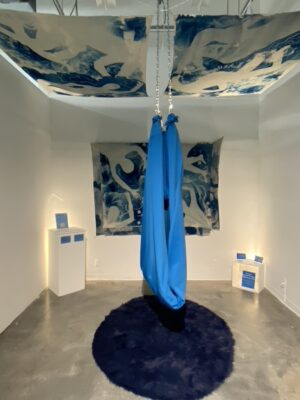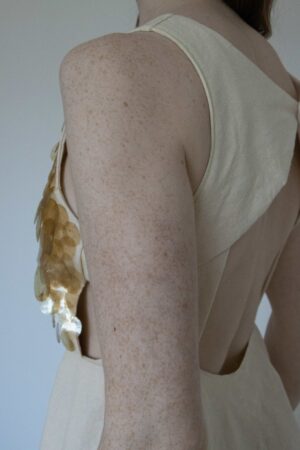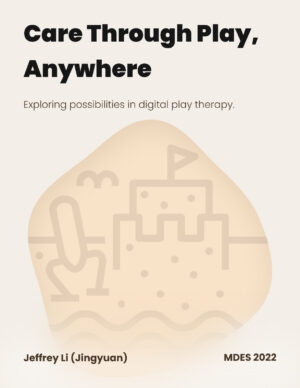More-than-Human Design
Zahra Jalali & Kimia Gholami

Abstract
This research is a critical quest to develop an inclusive More-than-Human (MtH) Design Process that recognizes non-human beings as valuable participants. This approach is meant to actively acknowledge the interconnectedness and interdependence of humans and other beings and act as an intervention in different stages of the “Design Thinking” process that is based on human-centred values. Through an MtH lens, this thesis questions the short-term profit-based model in the design industry that primarily benefits humans while bringing destructive consequences to the rest of the living planet. These consequences, such as global warming, loss of biodiversity, and environmental destruction, have foregrounded the need to take the agency of non-humans more seriously in the design discipline. The MtH Design Process expands the human-centred design methodology by borrowing methods from Interaction Design (IxD) and More-than-Human Participatory Research (MtH-PR).
This work has been structured in four main sections. In part 1, re-frame, we start our inquiry by looking at Interaction Design from a More-than-Human perspective. We include a series of place-based explorations in Vancouver B.C that challenged our old assumptions and biases towards different participants in design. In part 2, re-imagine, we work towards an MtH design practice by identifying its core values. These values guide several case studies that demonstrate how an MtH approach can alter existing products. Part 3, re-build, focuses on formalising the MtH design process by creating changes in different phases of the Design Thinking process. The MtH Design Process includes five steps – 1. Encounter 2. Learn 3. Plan 4. Map and 5. Build – all of which offer multiple methods, prompts, and points of inquiry into the MtH design practice. This work also includes the MtH design toolkit to support its pedagogical potential. The final part, re-connect, concludes the work by discussing the implications of MtH design and its potentials and challenges.
The More-than-Human World
In this project, we use the term More-than-Human (MtH), initially coined by ecologist David Abram (1997) in the subtitle of his book The Spell of the Sensuous to oppose the term human-connectedness. This term was used by Abram to describe the space of human culture as a subset within a larger set. It emphasises that the human world is necessarily sustained, surrounded, and permeated by the More-than-Human World. As language carries the weight of our actions and intentions, we refer to the More-than-Human World not as an opposition to the realm of humankind but as an expression of a realm that exceeds the human and the human-made. By MtH actors, we mean all the living self-originating entities of the planet, starting from the micro and expanding to the macro.

Design in the Era of Ecological Crisis
The ways in which humans perceive and interact with the More-than-Human World have undergone drastic changes in the Anthropocene era. Fueled by human exceptionalism and seeing nature as an endless resource for exploitation, humans have long overlooked the interconnectedness of their livelihoods with other beings. The climate crisis and the loss of biodiversity are perhaps the most prominent evidence of this dysfunctional relationship, showing how imperative it is for the current status to change. Meanwhile, design disciplines today are commonly involved in a service profession that works towards meeting human needs (Friedman & Stolterman, 2018); a profession that is partly responsible for the planet’s ecological crisis by exploiting non-human beings, materials, and resources. In other words, design has directly contributed to this ongoing crisis by attending to human-centred values and framing out the rest of the living planet.
This research aims to be a More-than-Human exploration into the design practice. Drawing from the collective endeavours in the realm of post-anthropocentric design, we found ourselves questioning our ways of practice. We asked, how can design take into account the needs and wishes of the planet as well as humans? In an industry where Human-Centred Design in many cases leads to more profit by instrumentalizing the natural world, how can design be framed from a More-than-Human perspective? What kind of interaction(s) exist in this more-than-human space? Who are the beings that are involved in this interaction? What are the implications of this interaction, and how can they inform the design process?
Friedman,K., Stolterman, E. (2018). Series Foreword. In Rosner D. K. Critical Fabulations: rewording the methods and margins of design. (1st ed., p.p ix). MIT Press.
1. Re-frame
As Interaction Designers, we saw it fit to start this exploration in our own discipline. Therefore, we began our inquiry by looking at Interaction Design, from a More-than-Human perspective; by first conducting a literature review and then conducting a series of place-based design actions to complement the theories discovered:
Literature review:
Bridging Interaction Design with More-than-Human Participatory Research
Our literature review started with a series of questions: In the era where instrumentalizing the natural world leads to more profit, how can design be framed from a More-than-Human perspective? What kind of interaction(s) exist in this more-than-human space? What are the implications of this interaction, and how can they inform the design process?
To answer these questions, we began by conducting a literature review to explore the field of interaction design and discuss the need for a non-human-centred view in the field. By weaving the alternate non-human-centred practices of IxD with the contributions of More-than-Human Participatory Research (MtH-PR), we saw an opportunity for Interaction Design to adapt a More-than-Human perspective.
Methodology:
place-based explorations of [dis]placement
To investigate our proposed approach, we conducted several design actions to challenge our existing knowledge of human-centred design and attempt to reevaluate it in a More-than-Human context. We created design experiments that involved non-human beings as their main participant rather than human users. The seven methods we chose for this series of experiments were: 1) empathy maps and personas, 2) Shadowing, 2) scenarios, 3) interview, 4) user journeys, 5) mapping, and 6) sound sketching; Many of which are commonly used in IxD and other design fields as well. Each of these methods corresponded with a particular location we chose based on the nature spectrum, described by Jordan & Hinds, 2016).


2. Re-Imagine
To move toward a More-than-Human Design practice, first, we had to identify the values that we want to put forward in a More-than-Human design process. Therefore, in part 2, Re-imagine, we devised the MtH values. These values were used to reevaluate a number of existing products in the market and helped us imagine an alternative MtH design for them.
MtH Design Values
Relating, Unlearning, Agency, Active Communication, Reciprocity, Openness
As an example, to value agency is to acknowledge our interdependence and the power of our actions; to look beyond human communities and learn from more-than-human beings as experts of their knowledge. In an MtH design practice, the non-human beings are not considered as objects of study or resources, but beings of agency that we can communicate and collaborate with.
Re-design Case studies
PlantNet (https://identify.plantnet.org):
An app that lets users identify the plants by uploading an image of them and being redirected to secondary resources, such as Wikipedia, for more information. The redesigned app from an MtH perspective would not only help users identify plants, but also encourages further hands-on interaction to build a stronger relationship. The new user flow focuses more on storytelling, and exploring histories, and would treat plants as active members of a community. Encountering a new plant is like encountering a new person; exciting, intriguing, and thought-provoking.

3. Re-build
Part 3, focuses on formalising the MtH design process by creating changes in different phases of the Design Thinking methodology.
MtH Design process:
We contemplated the different ways we can structure a more-than-human design framework. As working designers, we wanted to be able to translate our findings into our own workflow. And this goal led us to develop a More-than-Human Design process. To do that, we sought to intervene in different spaces of an existing design process to rebuild it from an MtH perspective. Thinking about human-centred design processes used in the industry, we immediately landed on “Design Thinking” as one of the most dominant frameworks that are present in both industry and academia and used it as a basis for our work. The MtH design process includes five steps: 1- Encounter 2- Learn 3- Plan 4- Map and 5- Build, all of which offer multiple methods, prompts, and points of inquiry into the MtH design practice.





4. Re-connect
Part 4, concludes the work by discussing the implications of MtH design and goes over its potential and challenges.
MtH workshops in collaboration with Emily Carr DESIS Lab:
In the final part of our research, we had the chance to collaborate with the DESIS Lab at Emily Carr University and facilitate two workshops with our colleague Marcia Higuchi (MDes 2022). These workshops gave us the chance to open up conversations about our relationship with More-than-Humans and partnering with them as potential creative collaborators. The participants were engaged in reflections, storytelling, and making as a way of practicing reciprocity towards the MtH world. Having gathered valuable insights and feedback from these sessions, we think workshops can be a great way to explore the MtH space and introduce the MtH design process.


Conclusion:
This thesis is an exploration of a More-than-Human approach in the design practice. An exploration that heavily relied on collaboration and partnership, not only because of the complexity of the topic but also because of the humble role we play as designers within the entangled network of humans and non-humans. As designers and researchers, we strongly feel that there should be more space and encouragement for collaboration in design research, and we hope this co-authored piece highlights the potential and possibilities of this type of work. We acknowledge the challenges that will possibly come with adopting the MtH approach, which would require breaking away from the systems that encompass and affect us in various ways. However, we believe that an MtH perspective can be brought into the design industry gradually, incrementally, and on different levels. We are excited to be able to share this work online and hope to continue to evolve and grow through forming more collaborations.
Zahra is a MDes (Interaction) graduate at Emily Carr University of Art + Design. She aspires to situate her design practice in relation to the local environment and emphasize the extensive human and non-human entanglement. Before joining Emily Carr, Zahra co-founded a studio and worked as a product developer while pursuing a BA in Visual Communications. Since then, she has worked as a UX and visual designer in several studios and startups. Her current research draws inspiration from nature and digital technology, where she is searching for new ways to design interactions that bring us closer to the more-than-human world.
Kimia is an industrial design graduate from the University of Tehran. She co-founded a studio during her undergraduate studies and has worked there since to develop products. She recently graduated with a master’s degree (Interaction) at Emily Carr University of Art + Design. In her practice, she is trying to pursue a more sustainable approach in Interaction design, where not only humans but also other beings (plants, animals, elements, etc) are taken into account in the design process. Her research focuses on visual storytelling and finding ways to reconnect people with their local natural environment in the age of climate crisis.



